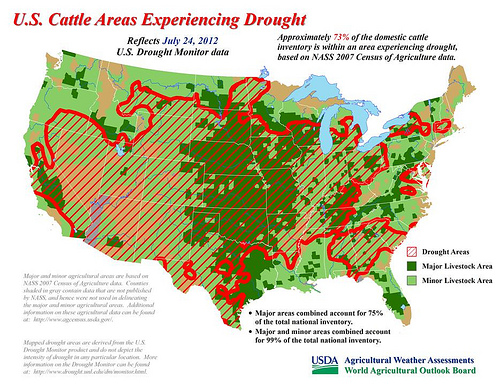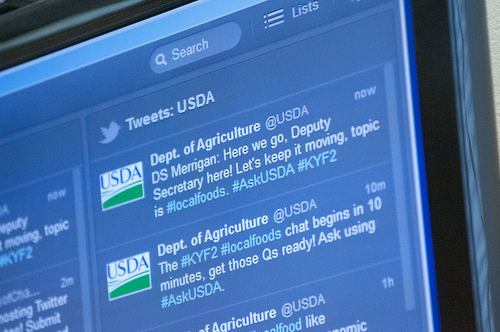
Approximately 73% of the domestic cattle inventory is within an area experiencing drought, based on NASS 2007 Census of Agriculture data. Click to enlarge map.
During the week ending July 24, 2012, the portion of the contiguous United States in drought inched upward to 64%, according to the U.S. Drought Monitor. The Drought of 2012 continues to hit some of the nation’s most important agricultural regions especially hard, with more than seven-eighths of the nation’s corn (89%) and soybeans (88%) considered to be within an area experiencing drought. In addition, more than one-third of both crops, 37% of the corn and 35% of the soybeans, are currently experiencing the two worst categories of drought – extreme to exceptional – designated by D3 and D4, respectively, on the Drought Monitor. Read more »
Cross posted from the White House blog:
America’s national parks, forests, wildlife refuges, and other outdoor spaces are treasured for their beauty, their enjoyment, and for their value to our culture and history — sometimes, it can be easy to overlook that they also serve as economic drivers for American communities. In sectors ranging from tourism to outdoor recreation and energy development, our nation’s public lands and waters are creating jobs and supporting local economies across the country.
Today, the U.S. Department of Agriculture (USDA) released an annual visitor survey, which highlights how our nation’s forests are contributing billions of dollars to the economy and creating jobs in tourism, restoration, and renewable energy. The report showed that USDA Forest Service lands attracted 166 million visitors in 2011, and, as a result, visitor spending in nearby communities sustained more than 200,000 full- and part-time jobs. The survey also reveals that these jobs produced labor income of more than $7.6 billion, while forest and grassland visitor spending contributed more than $13 billion to the gross domestic product. Read more »

The U.S. Forest Service recently announced nearly $4 million in grants to help develop affordable woody biomass energy in rural communities. The facilities will use wood pellets such as those pictured here. Thinkstock
The U.S. Forest Service recently announced the award of nearly $4 million in grants for wood energy projects around the country to help expand regional economies and create new jobs. The grants, totaling $3.9 million, will be distributed to 20 small businesses, tribes and community groups to develop renewable energy projects. Read more »

Prescribed burn at the Tahoe National Forest. (Photo: Steve McKelvey, U.S. Forest Service
There’s hot debate over whether or not to conduct prescribed burning and mechanical thinning (the manual removal of trees) in our nation’s forests. Supporters of these fuels reduction methods, which remove highly flammable undergrowth, argue that they help lower the severity of wildfires. Meanwhile, opponents say that the treatments can hurt the environment. Read more »

The moment of truth: USDA Rural Development State Director for Michigan James J. Turner (fourth from right) cuts the ribbon to Williamston’s new water treatment plant with Willamston Mayor James DeForest.
The grand opening of Williamston, Michigan’s Water Treatment Plant featured an unusual beverage as its centerpiece: Tap water. Along with a celebratory cake and other snacks, the organizers offered up large chilled containers of Williamston’s new and improved drinking water – and residents were happy to help themselves. Read more »

Agriculture Deputy Secretary Kathleen Merrigan, hosts a live Twitter chat focused on the Department’s support of local and regional food systems and the recent release of the 2.0 version of the Know Your Farmer, Know Your Food Compass on Tuesday, July 24, 2012, in Washington, D.C.
When we first launched the Know Your Farmer, Know Your Food Compass in February, we knew you would use this digital record to explore USDA’s work on local and regional food. And you have. Read more »





